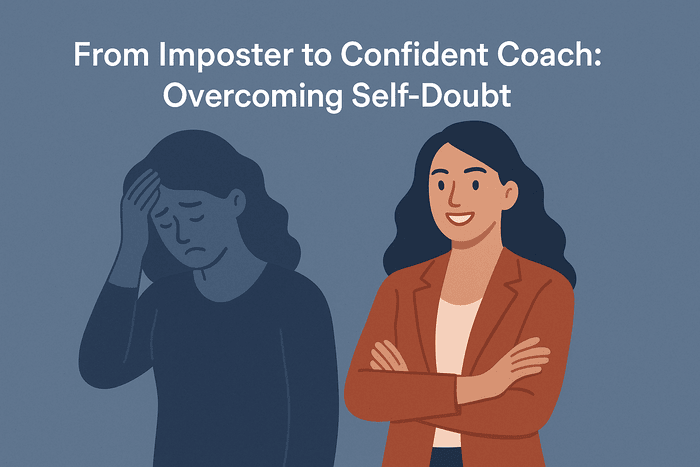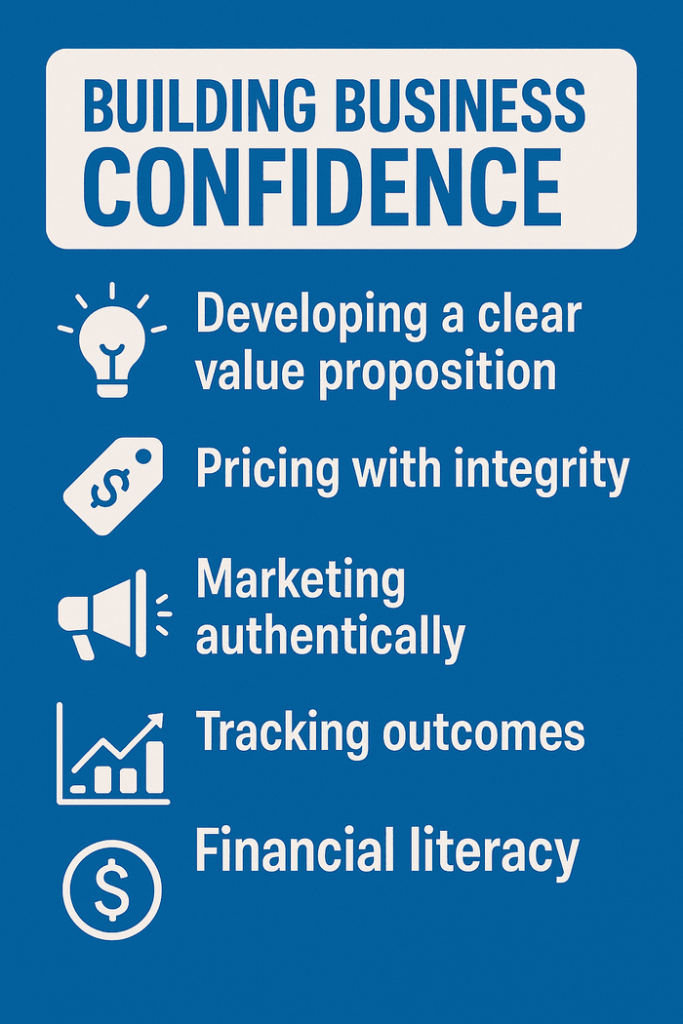
India’s economy has transformed dramatically over the last decade, and the demand for top business coach India services has grown...
When you step into the role of coach, you sign up to guide others to clarity, confidence and growth. Yet many new and even experienced coaches secretly struggle with imposter syndrome—that nagging feeling of being a fraud despite evidence of competence. You may worry that your success is just luck or that someone will “find out” you’re not as capable as you appear. You’re not alone. Imposter syndrome is a common psychological pattern characterised by persistent self‑doubt and fear of being exposed as inadequate. It affects people across professions and can take a toll on mental health. In coaching, where your confidence and presence are tools of the trade, self‑doubt can undermine your effectiveness and your clients’ trust.
This extensive article is designed to help you understand the roots of imposter syndrome and transform self‑doubt into unwavering confidence. Drawing on research, psychological frameworks, neuro‑linguistic programming (NLP) principles and practical experience, we will explore why coaches experience imposter feelings, how to recognise the signs, and actionable strategies to overcome them. We will also integrate insights from NLP and positive psychology to reframe limiting beliefs, so you can develop a resilient, confident coaching identity.

Imposter syndrome is more than occasional self‑doubt; it’s a chronic, pervasive feeling of inadequacy that persists despite external evidence of success. It often manifests as:
Coaching is a relational profession. Unlike roles with clear deliverables, coaching outcomes are subjective and often intangible. This makes it easy to question your impact. Common triggers of imposter feelings include:
Psychologists have identified five common patterns of imposter syndrome: the perfectionist, the expert, the soloist, the natural genius and the superhero. Each has its own triggers and coping strategies. Perfectionists set unrealistically high standards and beat themselves up for minor mistakes. Experts feel they must know everything before starting. Soloists believe they must do it all alone. Natural geniuses expect instant mastery. Superheroes juggle multiple roles flawlessly. Understanding your dominant pattern can help you choose targeted interventions.
Imposter syndrome doesn’t just cause fleeting discomfort; it can have serious consequences. Chronic self‑doubt erodes self‑esteem, increases stress levels and contributes to burnout. Coaches may overprepare for sessions, avoid taking on challenging clients or undercharge for fear of overpromising. Over time, self‑doubt can lead to procrastination, indecision and missed opportunities. It may also cause you to mirror limiting beliefs onto your clients, hindering their growth. Recognising the emotional and physical toll of imposter syndrome is the first step toward change.
To overcome imposter syndrome, you must become aware of its manifestations. Signs include:
Assess yourself honestly. Which signs resonate? Awareness provides a baseline for change.
Overcoming imposter syndrome is not a one‑time fix; it’s an ongoing practice of noticing thought patterns, reframing beliefs and building new habits. Here are evidence‑based strategies to help you move from imposter to confident coach:
The first step is to recognise and accept imposter feelings. Understand that many successful people experience them. Normalising the experience reduces shame and isolation. Journaling about your thoughts or sharing them with peers can provide relief. Consider joining a mastermind group where coaches openly discuss their challenges.
Negative self‑talk fuels imposter syndrome. Challenge these thoughts and replace them with evidence‑based reframes. For example, if you think “I’m not experienced enough,” list your accomplishments, training and positive feedback. Replace “I’ll fail” with “I’m learning and growing.” Cognitive restructuring (a cognitive‑behavioural technique) trains your brain to think more rationally. Using NLP reframing methods, you can identify unhelpful internal dialogue and consciously choose more empowering perspectives.
Keep a “success journal” to record achievements, compliments and breakthroughs. Reviewing this journal before sessions or interviews reminds you of your competence. Celebrate small wins—landing a client, crafting a powerful question, or receiving a heartfelt testimonial. Public recognition is not necessary; private acknowledgements can be equally powerful in building confidence.
Perfectionism often hides fear of failure. Cultivating self‑compassion helps you treat yourself with the same kindness you offer clients. Acknowledge that mistakes are part of growth and that worth isn’t contingent on flawless performance. Mindfulness exercises can develop self‑compassion by allowing you to witness thoughts without judgment.
Embrace the idea that skills are developed through effort and feedback. See challenges as opportunities rather than tests of worth. A growth mindset fosters resilience and persistence in the face of setbacks. Consider adopting the mantra “Not yet” instead of “I can’t.” This shifts your perception from fixed ability to evolving capability.
Discussing imposter syndrome with trusted mentors or peers can be liberating. Coaches who have walked a similar path can share strategies and reassure you that your feelings are common. Consider formal supervision, where you can explore challenges in a confidential setting. Building a supportive network normalises vulnerability and fosters mutual growth.
Aim for excellence, not perfection. Set achievable goals and break them into manageable steps. Overly ambitious goals increase stress and confirm feelings of inadequacy when not immediately achieved. Use SMART (specific, measurable, achievable, relevant and time‑bound) goals to structure your progress.
Imposter syndrome sometimes stems from actual gaps in knowledge or skills. Continual learning builds competence and confidence. Invest in coach training, credentials and supervision. Solicit feedback from clients and colleagues and view it as an opportunity to improve, not a judgment of your worth.
Remember that coaches are facilitators, not gurus. Your value lies not in having all the answers but in asking powerful questions, holding space and trusting the client’s process. Reframe your role from “I must fix my clients” to “I accompany clients on their journey.” This perspective reduces pressure to be perfect.
Neuro‑linguistic programming offers tools to reprogram internal dialogue. Anchoring links a positive emotional state to a physical trigger, allowing you to access confidence quickly. Reframing helps you view situations from different angles, transforming limiting beliefs into empowering ones. Visualization involves mentally rehearsing successful outcomes, which builds neural pathways associated with confidence. Practise these techniques regularly to prime your brain for success.
Beyond addressing imposter syndrome, developing enduring confidence involves cultivating a strong professional identity, continuous growth and authentic self‑expression.
Define your niche, values and philosophy. Knowing who you are and what you stand for creates clarity. Write a mission statement describing how you serve clients and the impact you aim to make. A clear identity reduces comparison because it emphasises unique contribution.
Journal after sessions: what went well, what you learned and what you would do differently. Reflective practice deepens self‑awareness and highlights progress. It also identifies areas to refine, enabling targeted improvement.
Participate in communities of practice, supervision groups or mastermind circles. Sharing successes and challenges fosters connection and normalises vulnerability. Receiving and offering feedback expands perspective and strengthens skills.
Sharing your journey—including struggles—humanises you and builds rapport with clients. Storytelling also reframes your experiences as learning opportunities, reinforcing your growth mindset. When you own your narrative, you stop feeling like an imposter and start embodying a role model.
Develop a pre‑session routine: review your success journal, practise an anchoring gesture, visualise a successful coaching conversation and take a few deep breaths. Such rituals prime your mind and body for presence and confidence.
Confidence doesn’t require omniscience. Admit when you don’t know an answer. Model curiosity by saying, “Let’s explore that together.” Clients appreciate authenticity more than perfection. Embracing uncertainty shows courage and invites clients to do the same.
Sarah, a newly certified life coach, felt like a fraud whenever she signed a client. She worried that her corporate background wasn’t relevant to coaching. After months of anxiety and undercharging, she enrolled in a supervision group where coaches discussed their doubts openly. Realising her feelings were common lifted her shame. Sarah began keeping a success journal and practised NLP anchoring by squeezing her fist whenever she recalled a proud moment. Before sessions, she reviewed her mission statement and took a deep breath. Over time, her confidence grew; she raised her rates, attracted clients aligned with her niche and even started mentoring other coaches. Sarah’s transformation illustrates how normalising self‑doubt, reframing thoughts and taking strategic action can turn imposters into leaders.
Understanding how the brain processes thoughts and emotions can help you apply techniques more effectively. The limbic system is the brain’s emotional centre; when triggered by fear, it can hijack rational thinking. Mindfulness and breathing activate the parasympathetic nervous system, calming the limbic response and allowing the prefrontal cortex (responsible for rational thinking and planning) to take the lead. Mirror neurons enable us to pick up on others’ emotions and behaviours. As a coach, your calm demeanour can help clients regulate their own nervous system; likewise, modelling self‑confidence can help you internalise it. Combining NLP’s cognitive techniques with neuroscience‑informed practices such as mindfulness amplifies transformation.
Limiting beliefs are deeply held assumptions that constrain what we think is possible. Examples include “I’m not smart enough,” “I need another certification to be credible,” or “I’ll never make a living from coaching.” These beliefs often originate in childhood experiences, cultural messages or critical moments of failure. They are perpetuated by confirmation bias: we notice evidence supporting our belief and ignore counterexamples. To reframe limiting beliefs:
To move from imposter to confident coach:
Confidence is not a destination but a dynamic state that grows as you take courageous action. When you reframe self‑doubt as a sign of growth and apply these tools consistently, you transform imposter feelings into fuel for learning. As you step into your power, you will not only become a more confident coach but also a powerful model for your clients, demonstrating that it is possible to overcome self‑doubt and thrive.
Imposter syndrome is not a formal diagnosis, but it is closely linked to psychological constructs studied in cognitive psychology. Cognitive distortions—thinking patterns that warp reality—play a key role. These include catastrophizing (expecting the worst), discounting the positive (rejecting compliments), all‑or‑nothing thinking and personalization (taking things too personally). When you constantly interpret events through these distorted lenses, your brain strengthens neural pathways associated with fear and shame. Neuroscientists have found that the amygdala, the brain’s threat detection centre, lights up when we perceive social evaluation, triggering a stress response. This fight‑or‑flight reaction can hijack rational thinking and feed self‑doubt. Meanwhile, the prefrontal cortex, responsible for reasoning and self‑reflection, can be weakened under chronic stress. Mindfulness and cognitive reappraisal strengthen this region, improving self‑regulation and reducing imposter symptoms. Understanding the neurological underpinnings of self‑doubt helps you approach it with compassion rather than self‑criticism.
Another factor is self‑handicapping, where people undermine their performance so they have an excuse for failure (e.g., procrastination). This behaviour preserves self‑worth but perpetuates underachievement. Coaches may avoid marketing or raising prices to protect themselves from potential rejection. Recognising self‑handicapping patterns allows you to intervene early.
Cognitive work is essential, but imposter syndrome also manifests in the body. Anxiety may show up as tightness in the chest, shallow breathing or clenched jaws. Mindfulness and embodied practices help you notice and release these sensations. Techniques include:
Embodiment also includes posture and voice. Standing tall and speaking clearly send signals of confidence to your nervous system. Adopting a confident posture activates a neuroendocrine cascade that reduces cortisol and increases testosterone, a hormone linked to assertiveness. Practise “power posing” before big sessions to prime your state.

For many coaches, imposter syndrome is intertwined with the entrepreneurial challenges of running a coaching practice. Building business confidence involves:
Confidence grows in community. Surround yourself with people who challenge and uplift you. Your ecosystem may include:
An effective support system balances constructive feedback with encouragement. Be intentional in choosing people who align with your values and respect your vulnerability.
Even with growth, imposter feelings can resurface—before a keynote presentation, after receiving critical feedback or when facing a complex client challenge. Prepare for these moments:
Anticipating setbacks prevents you from interpreting them as evidence that you’re a fraud. Instead, they become signals to apply your strategies.
Transforming from imposter to confident coach is not a linear path. It’s a dynamic journey of self‑awareness, mindset shifts, learning and community. Imposter syndrome thrives in secrecy but loses power in the light of compassionate attention. When you understand the psychological and neurological roots of self‑doubt, you can address it at its core. By practising cognitive restructuring, embracing mindfulness, building business skills and cultivating supportive relationships, you strengthen your inner foundation. Confidence doesn’t mean never feeling insecure; it means taking action despite insecurities and trusting that growth comes through practice. As you integrate these tools into your life and coaching practice, you’ll find yourself increasingly comfortable in your role, able to focus on serving clients and expanding your impact. The transition from imposter to confident coach will not only enhance your professional fulfilment but also inspire those you guide to believe in their own potential.
One of the most powerful antidotes to self‑doubt is continuous professional development. In a rapidly evolving field, staying current through courses, certifications and reading nourishes your competence and curiosity. Commit to a learning plan: choose topics that both excite you and fill gaps, whether advanced coaching skills, neuroscience, diversity and inclusion or business management. Each new skill or perspective becomes a brick in the foundation of your confidence.
Equally important is regular supervision. A supervisor acts as a mirror, providing feedback on your coaching practice, helping you process complex client situations and challenging unconscious biases. Supervision sessions are safe spaces to explore ethical dilemmas and personal triggers. Knowing you have professional oversight reduces anxiety because you’re not working in isolation. Many coaching bodies require supervision hours for credential renewal, underscoring its importance.
Ethics also bolster confidence. When you adhere to professional ethical codes—such as the International Coaching Federation’s standards on confidentiality, professionalism and boundaries—you reduce the fear of missteps and build trust with clients. Ethics provide clear guidelines when navigating grey areas, such as dual relationships or marketing claims. Familiarising yourself with these codes and seeking clarification when uncertain helps you operate with integrity and confidence.
Confidence blossoms when your actions align with your deeper purpose. Take time to explore your values—the principles that matter most to you—and your vision for the world you want to create through your coaching. When you connect daily tasks to your larger purpose, even mundane activities feel meaningful. Purpose acts as a compass; when imposter feelings arise, you can anchor yourself in why you do this work. Many coaches find that a sense of calling replaces fear with gratitude and determination.
Finally, integrate self‑care and celebration. Coaching can be emotionally demanding. Prioritise rest, hobbies, social connection and activities that replenish you. Celebrate milestones—completing a training, receiving positive client feedback or maintaining boundaries. Celebration signals to your brain that effort leads to reward, reinforcing motivation. Surround yourself with reminders of your journey: certificates, thank‑you notes, photos from impactful retreats. These artifacts serve as evidence when doubt creeps in.
By weaving education, supervision, ethics, purpose and self‑care into your practice, you cultivate a holistic foundation for confidence. Over time, you will notice that the voice of self‑doubt grows softer, while your inner coach—wise, calm and courageous—speaks louder. You can then model this transformation for your clients, demonstrating that everyone has the capacity to move beyond limiting beliefs and embrace their inherent worth.
Imposter syndrome is a persistent feeling of inadequacy despite evidence of success, characterized by self-doubt and fear of being exposed as a fraud. Coaches experience it due to the subjective nature of coaching outcomes, lack of formal credentials, high client expectations, comparisons with other coaches, and perfectionist tendencies.
Signs include attributing success to luck, discounting praise, fearing failure, overworking to prove worth, all-or-nothing thinking, and cycling between intense effort and temporary relief. Noticing these patterns through self-reflection or journaling is key to addressing them.
Strategies include normalizing feelings, reframing negative thoughts, celebrating successes, practicing self-compassion, adopting a growth mindset, seeking mentorship, setting realistic goals, building competence through training, reframing the coaching role as facilitation, and using NLP techniques like anchoring and visualization.
NLP techniques like anchoring (linking confidence to a physical trigger), reframing (shifting limiting beliefs to empowering ones), and visualization (mentally rehearsing success) rewire internal dialogue and neural pathways, reducing self-doubt and building confidence by creating evidence of capability.
Ongoing education through courses and certifications builds competence, while supervision and peer networks provide feedback, normalize struggles, and foster accountability. Aligning with ethical standards and a clear purpose enhances confidence by grounding coaches in their values and impact.

India’s economy has transformed dramatically over the last decade, and the demand for top business coach India services has grown...

When searching for a certified life coach program price, it’s natural to start by comparing tuition fees. Aspiring coaches want...

Neuro-Linguistic Programming (NLP) is experiencing a resurgence in India. Social media, workshops and high-energy seminars promise instant breakthroughs by rewiring...

Many professionals pursue the title of Certified Organizational Development Coach with the expectation that a credential alone will open corporate...

Some providers offer to fast-track you to PCC status through purely online modules for a fraction of the cost of...

Executive coaching has evolved from a niche service for struggling leaders into a strategic investment for organisations aiming to build...

When prospective coaches research training options, cost is often the first number they look for. A quick internet search produces...

Deciding to invest in life coach training programmes can be a transformative milestone in your personal and professional journey. In...

Choosing the right online life coaching courses can be one of the most transformative decisions you ever make.